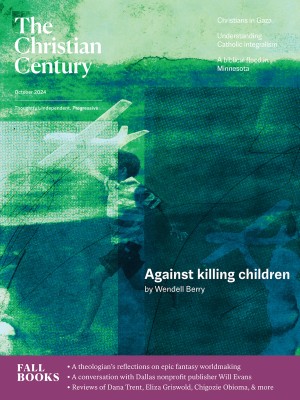Illuminating Qohelet through art and philosophy
Debra Band and Menachem Fisch’s beautiful creation is not your typical Ecclesiastes commentary.

Qohelet
Searching for a Life Worth Living
Years ago, when I told my young son about a Bible commentary I was writing, he paused for a minute and then dryly commented, “So it’s a book about a book.” A humbling but apt assessment! If a Bible commentary is a book about a book, Qohelet: Searching for a Life Worth Living is a book about a book with pictures. It offers something quite different from usual commentaries: artistic renderings of the text alongside philosophical insights, all in conversation with interpretations ranging from ancient to modern.
The richness of this interdisciplinary approach compels us to take a new—or a first—look at the Hebrew scroll that was rendered “Ecclesiastes” in Greek, a term carried through into Christian tradition. The coauthors invoke a kaleidoscope of references in their interpretations: Hubble Space Telescope images, ancient artifacts, medieval Jewish poetry and liturgy, Shakespeare, scientific philosophy, rabbinic literature, recent Qohelet scholarship, and of course, Hebrew Bible references galore.
Read our latest issue or browse back issues.
Debra Band is a visual artist whose similarly illuminated Song of Songs (The Song of Songs: The Honeybee in the Garden) caught my attention years ago, so I was eager to see her pictorial interpretation of my favorite sage. Menachem Fisch is a philosopher of science with emeritus status at Tel Aviv University and Goethe University Frankfurt and codirector of the Frankfurt–Tel Aviv Center for Religious and Interreligious Studies. He first became interested in Qohelet through the work of his Bible scholar father, Harold Fisch. As cousins, the coauthors, along with the elder Fisch posthumously contributing his translation of Qohelet, present us with a family treasure in this collaboration. The authors’ Jewish perspectives and familiarity with rabbinic texts provide a wealth of context that is too often absent from biblical commentaries.
With any illustrated book, most readers turn first to the pictures. Band illuminates Qohelet in both pointed Hebrew (including the vowel marks) and English. This bilingual approach means she has illuminated the whole book twice, wherein the facing pages complement one another and unite the two languages.
Band’s calligraphy is a masterpiece. She presents every word of the book in lovely hand-drawn letters. The first three pages of illuminations additionally include the entire unpointed Hebrew text of Qohelet as micrography, a traditional Jewish art form in which minutely lettered passages outline pictures or patterns. Fisch’s artful words and Band’s words bent into art show how a text can both bind us to meaning and launch us beyond the comprehensible. Some of the reproductions of her art are a bit blurry, but the effect is breathtaking nonetheless. The printing process especially allows for the gold details to shine on the page.
Band’s illuminated Qohelet follows long-standing traditions in which visual art interprets, accompanies, and incorporates biblical texts. While her calligraphy makes the words of Qohelet the centerpiece of her work, the artist links those words to multiple interpretive possibilities through symbolic imagery; her art is not exactly abstract or realism. Yet her graphics beckon us out of our analytical brains into an expansive experience of the text. Nearly every detail of her illuminations has some specific meaning; paired with her explanations, this provides a bridge from abstract concepts to lived experiences.
Fisch’s artful words and Band’s words bent into art show how a text can both bind us to meaning and launch us beyond the comprehensible.
Band uses a medieval Spanish palace, the Alhambra, as a sustained model for her illuminations, all the way down to tile patterns. Though its historical context departs vastly from the authors’ assumed date of Qohelet in the Persian period (circa 539–332 BCE), the lively Jewish art and intellectual scene that surrounded the Alhambra becomes a fitting lens for Band’s imaginative process about Qohelet’s royal persona. While some Qohelet scholars do identify the Persian period as the context for the book (most notably Choon-Leong Seow in his Anchor Yale Bible commentary, Ecclesiastes), the majority have settled on a later date in the Hellenistic period due to similarities with Greek thought. The authors rightly acknowledge these differing views in ample footnotes.
For each chapter of Qohelet, Fisch provides about two pages of philosophical commentary. Each of his commentaries is directly followed by Band’s explanations of her art on that chapter. Fisch’s writing relies on complex concepts and analysis more typical of philosophical writing than of biblical commentaries. His footnotes indicate engagement with both biblical scholarship and a wide array of philosophical thought. The dense conceptual discussions from Fisch counterbalance Band’s imaginative art, as though encouraging both left and right brain engagement.
The authors chose Harold Fisch’s Qohelet translation for reasons both familial and academic. Its reliance on the King James Version gives it an outdated shade (“It is good that thou shouldst take hold of this; but do not withdraw thy hand from that either,” 7:18). The one change Band and Fisch make throughout the translation is to render each of the 38 occurrences of hevel as “vapour” rather than “vain” or “vanity.” The translation of hevel provides a key to every Qoheleth interpretation. Band and Fisch’s choice of a noun fits for their project, which takes the abstract musings of this ancient sage and depicts them concretely.
Band rightly addresses the androcentric language in this translation but notes that her illuminations respond to it by including numerous female figures. Indeed, in her visual interpretation of the book’s notoriously misogynistic verses, 7:26–29, Band uses micrography to depict both “Lady Wisdom” and the “other woman” from Proverbs, who symbolizes folly. This connection between the personified women of Proverbs and Qohelet 7:26–29 aligns with the work of numerous Bible scholars, including myself.
This multilayered and inviting book provides a marvelous opportunity for Christians to engage in thoughtful Bible study. Better yet, make it interfaith with a study group of both Jews and Christians.






